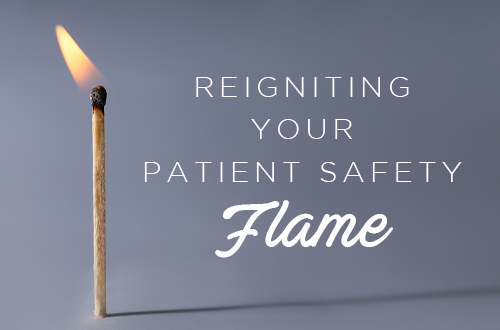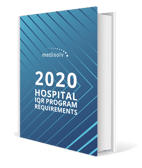Dear Medisolv: How Can I Reignite Our Passion for Patient Safety?

It’s the 20th anniversary of the IOM’s landmark report, “To Err is Human,” which sparked the modern patient safety movement. Since then, some health systems’ relationships with patient safety have gone stale. Our advice columnist helps reignite one reader’s passion for patient safety using quality data.
Dear Medisolv:
I’ve worked in a suburban hospital for the past 25 years. My job is attractive on the outside: We’re part of a prominent not-for-profit health system that positions itself as a leader in patient safety. We have a bevy of resources, a team of incredible doctors and surgeons, and I should be happy, right? Well, we just found out that Medicare will reduce our DRG payments by nearly 2% next year because our readmission rate was too high. This is the third year in a row that CMS has dinged us for having too many patients come back within 30 days after we discharged them. This doesn’t seem to bother anyone in the C-suite at our hospital (or at our parent health system), but I feel like things have gotten stale in our relationship with patient safety. I get the feeling everyone thinks it’s simply the cost of doing business with Medicare. They feel the same way about collecting and reporting quality data to Medicare and other payers. It’s become something we have to do to check off a box. We’re not using the data to make care safer or more effective for patients.
I want to reignite our passion for quality improvement in healthcare (and save money in the long term). What can I do to light that spark again?
Yours,
Hopeless in Healthcare Quality
Dear Hopeless in Healthcare Quality,
Hear me, Hopeless: Your relationship with patient quality improvement isn’t the only one in the industry that’s gone stale or seen more impassioned days. You and your health system, along with the entire industry, need to rekindle the flame of safer and more effective patient care.
But take heart! You are not alone. According to Kaiser Health News, Medicare will cut payments by an average of 0.71% to 2,583 hospitals in 2020 to penalize these hospitals’ high 30-day readmission rates.[i] The payment reductions will add up to $563 million from Oct. 1, 2019 through Sept. 30, 2020. You’re also not alone in having this happen annually. Medicare cut payments by $566 million to 2,599 hospitals in 2019 and by $564 million to 2,573 hospitals in 2018, according to the Advisory Board. [ii]
This problem isn’t limited to unnecessary and avoidable readmissions under Medicare’s Hospital Readmissions Reduction Program[iii], either. We see it in other programs and areas, too:
• CMS cut Medicare payments by 1% to 800 hospitals this year for patient safety problems, up from 768 hospitals the previous year, according to Kaiser Health News.[iv] CMS penalized 110 of the 800 hospitals for the fifth year in a row under its Hospital-Acquired Conditions Reduction Program.[v]
• In its 2018 National Healthcare Quality and Disparities Report[vi], the U.S. Agency for Healthcare Research and Quality assessed whether the healthcare industry is “improving,” “not changing” or “worsening” on 147 performance measures in six “quality of healthcare” domains. The industry either didn’t change or got worse on about 46% of the measures.
Here are some suggestions on how to improve your relationship with quality data.
Quality improvement in healthcare: Four ways to put the spark back
1. Create a strong culture of safety
Safety starts with the board of directors and includes everyone in the organization, from doctors to bedside care staff. And to be clear: it’s not enough to just measure patient safety. You have to do something different in your care delivery system as a result of the measurement. This actionable change requires strong commitment from executive leadership, and staff need to be willing to take responsibility for greater expectations. Rewarding leadership with financial incentives can also help ensure they steward the appropriate work redesigns, policies, staffing and training to ensure their numbers dramatically improve.
2. Celebrate patient safety anniversaries
Anniversaries are important to any relationship. They’re fantastic opportunities to celebrate the past and look forward to the future. November marks the 20th anniversary of the Institute of Medicine’s (now the National Academy of Medicine) landmark report “To Err Is Human: Building a Safer Health System.”[vii] This work launched the modern patient safety movement. (It so happens that Medisolv marked its 20th anniversary this year as well!) Use this anniversary to energize patient safety at your hospital. Hold an event like a seminar or conference featuring a guest patient safety speaker and renew your patient safety vows.
Find ways to celebrate your hospital’s own important anniversaries, like achieving zero central line infections or preventing any ventilator acquired-pneumonias in the ICU. Celebrate nursing units that haven’t had a patient fall in more than 90, 120 or 365 days. Make these celebrations meaningful, and make every provider in that unit feel special and appreciated. Add that spark (and joy!) back into their relationship with their job. Include a monetary bonus, even if it’s small.
3. Experiment with digital health apps
Explore and investigate all the new digital health tools and applications coming into the market that can make care more effective. You can search for patient safety apps online. You can also contact one of the 52-AHRQ designated patient safety organizations near you for their recommendations or network with other hospitals that have demonstrated success.[viii] A piece of advice within this advice: do use caution when you choose your technology. Never implement a clinical decision support alert unless you have a well-defined process response to implement along with it. Otherwise, alert fatigue sets in, and providers start to ignore them altogether.
4. Bring clinical quality measures into your relationship
While at first glance, it may not seem too important to engage with electronic clinical quality measures (eCQM) data, it really does have the potential to help reignite the spark in your relationship with patient safety. Your hospital collects and reports eCQM data to Medicare, Medicaid, commercial payers and private accrediting agencies like The Joint Commission. Rather than seeing eCQM data as something you have to do to “check off a box” (as you referred to it, Hopeless), it can be a rich source of information to improve patient care.
You can make your eCQM data a regular and systematic part of your quality management program. When you do that, you have the ability to connect the dots between your performance on your measures and your patient safety record. By focusing on these measures, you’ll be doing your part to improve the effectiveness of the care that you deliver and improve patient safety at the same time.
I am confident that by trying these relationship boosters, the spark between your health system and patient safety measures will return in no time.
Yours in patient safety,
Ask Medisolv
Is your relationship with quality improvement in healthcare in the doldrums? Send your questions to questions@medisolv.com or tweet us at @medisolv.
[i] “New Round of Medicare Readmission Penalties Hits 2,583 Hospitals.” Kaiser Health News. https://khn.org/news/hospital-readmission-penalties-medicare-2583-hospitals/
[ii] “Map: See the 2,599 hospitals that will face readmission penalties this year.” Advisory Board. https://www.advisory.com/daily-briefing/2018/09/27/readmissions
[iii] Hospital Readmissions Reduction Program (HRRP). Centers for Medicare and Medicaid Services. https://www.cms.gov/Medicare/Medicare-Fee-for-Service-Payment/AcuteInpatientPPS/Readmissions-Reduction-Program.html
[iv] “Medicare Trims Payments to 800 Hospitals, Citing Patient Safety Incidents.” Kaiser Health News. https://khn.org/news/medicare-trims-payments-to-800-hospitals-citing-patient-safety-incidents/
[v] Hospital-Acquired Condition Reduction Program (HACRP). Centers for Medicare and Medicaid Services. https://www.cms.gov/Medicare/Medicare-Fee-for-Service-Payment/AcuteInpatientPPS/HAC-Reduction-Program.html
[vi] 2018 National Healthcare Quality and Disparities Report. Agency for Healthcare Research and Quality. https://www.ahrq.gov/research/findings/nhqrdr/nhqdr18/index.html
[vii] To Err is Human: Building a Safer Health System. Institute of Medicine. https://www.ncbi.nlm.nih.gov/pubmed/25077248
[viii] Patient Safety Organization (PSO) Program. Agency for Healthcare Research and Quality. https://www.pso.ahrq.gov/
FREE DOWNLOAD:
2020 Hospital IQR Program Requirements eBook
Ensure a smooth and stress-free submission to the Hospital Inpatient Quality Reporting (IQR) program. Download the 2020 IQR Program Requirements eBook, which includes all you need to know to successfully complete the program in 2020.
 |
This guide includes:
|




Comments